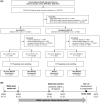Clinical implications of renin-angiotensin system inhibitors for development and progression of non-alcoholic fatty liver disease
- PMID: 33536442
- PMCID: PMC7858633
- DOI: 10.1038/s41598-021-81959-1
Clinical implications of renin-angiotensin system inhibitors for development and progression of non-alcoholic fatty liver disease
Abstract
Recently, there has been an increasing interest in the therapeutic efficacy of RAS inhibitors (RASi) in patients with non-alcoholic fatty liver disease (NAFLD) because they may reduce oxidative stress, inflammatory markers, and enhanced fibrosis. An objective of this study was to investigate the role of RASi on NAFLD development and progression in a large cohort. We conducted a nested case-control study. Study subjects were classified into two study cohorts according to baseline NAFLD status: non-NAFLD (n = 184,581) and established NALFD (n = 27,565). An NAFLD development or progression case was defined as a patient with newly developed NAFLD or new progression of advanced fibrosis from non-NAFLD and established NALFD cohorts, respectively. A conditional logistic regression analysis was conducted to estimate the associations between RASi exposure and NAFLD development/progression. Overall, no significant association was evident between RASi use and NAFLD development or progression (NAFLD development; ever-user vs. never-user: OR 1.017; 95% CI 0.842-1.230, NAFLD progression; ever-user vs. never-user: aOR 0.942; 95% CI 0.803-1.105). RASi ever-use in cases of individuals who were obese or who had normal fasting plasma glucose (FPG) was associated with reduced risk of both NAFLD development (body mass index (BMI) ≥ 25 kg/m2: 0.708 [95% confidence interval (CI) 0.535-0.937], FPG of < 100 mg/mL: 0.774 [95% CI 0.606-0.987]) and progression (BMI ≥ 25 kg/m2: 0.668 [95% CI 0.568-0.784], FPG of < 100 mg/mL: 0.732 [95% CI 0.582-0.921]). The present study did not verify a significant overall association between RASi use and NAFLD development/progression but suggested that RASi might prevent NAFLD development and progression among specific subjects.
Conflict of interest statement
The authors declare no competing interests.
Figures
Similar articles
-
Do renin-angiotensin system inhibitors reduce risk for hepatocellular carcinoma?: A nationwide nested case-control study.Clin Res Hepatol Gastroenterol. 2021 Jul;45(4):101510. doi: 10.1016/j.clinre.2020.07.015. Epub 2020 Dec 4. Clin Res Hepatol Gastroenterol. 2021. PMID: 33272886
-
The impact of Renin-Angiotensin System Inhibitors on bone fracture risk: a nationwide nested case-control study.BMC Musculoskelet Disord. 2024 Jan 2;25(1):3. doi: 10.1186/s12891-023-07102-5. BMC Musculoskelet Disord. 2024. PMID: 38166774 Free PMC article.
-
Renin-angiotensin system and fibrosis in non-alcoholic fatty liver disease.Liver Int. 2015 Mar;35(3):979-85. doi: 10.1111/liv.12611. Epub 2014 Jul 5. Liver Int. 2015. PMID: 24905085
-
Global prevalence, incidence, and outcomes of non-obese or lean non-alcoholic fatty liver disease: a systematic review and meta-analysis.Lancet Gastroenterol Hepatol. 2020 Aug;5(8):739-752. doi: 10.1016/S2468-1253(20)30077-7. Epub 2020 May 12. Lancet Gastroenterol Hepatol. 2020. PMID: 32413340
-
Non-alcoholic fatty liver disease and hypertension: coprevalent or correlated?Eur J Gastroenterol Hepatol. 2018 Sep;30(9):979-985. doi: 10.1097/MEG.0000000000001191. Eur J Gastroenterol Hepatol. 2018. PMID: 30048367 Review.
Cited by
-
Impact of Maternal Obesity on Liver Disease in the Offspring: A Comprehensive Transcriptomic Analysis and Confirmation of Results in a Murine Model.Biomedicines. 2022 Jan 27;10(2):294. doi: 10.3390/biomedicines10020294. Biomedicines. 2022. PMID: 35203502 Free PMC article.
-
Chrysin Attenuates Fructose-Induced Nonalcoholic Fatty Liver in Rats via Antioxidant and Anti-Inflammatory Effects: The Role of Angiotensin-Converting Enzyme 2/Angiotensin (1-7)/Mas Receptor Axis.Oxid Med Cell Longev. 2022 Jun 8;2022:9479456. doi: 10.1155/2022/9479456. eCollection 2022. Oxid Med Cell Longev. 2022. PMID: 35720181 Free PMC article.
-
Signature gene expression model for quantitative evaluation of MASH-like liver injury in mice.Toxicol Appl Pharmacol. 2025 Sep;502:117442. doi: 10.1016/j.taap.2025.117442. Epub 2025 Jun 15. Toxicol Appl Pharmacol. 2025. PMID: 40527436
-
Effects of renin-angiotensin inhibitors on renal function and the clinical course in patients with decompensated cirrhosis.Sci Rep. 2023 Oct 14;13(1):17486. doi: 10.1038/s41598-023-44299-w. Sci Rep. 2023. PMID: 37838780 Free PMC article.
-
Guideline for the Prevention and Treatment of Metabolic Dysfunction-associated Fatty Liver Disease (Version 2024).J Clin Transl Hepatol. 2024 Nov 28;12(11):955-974. doi: 10.14218/JCTH.2024.00311. Epub 2024 Nov 4. J Clin Transl Hepatol. 2024. PMID: 39544247 Free PMC article.
References
MeSH terms
Substances
LinkOut - more resources
Full Text Sources
Other Literature Sources
Medical


